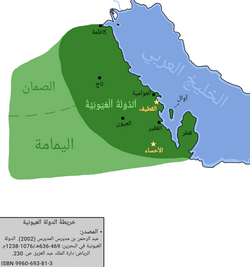This article has multiple issues. Please help improve it or discuss these issues on the talk page. (Learn how and when to remove these messages)
|
The Uyunid Emirate (Arabic: الدَّوْلَةُ الْعُيُونِيَّة) was a historical Arab emirate centered in al-Hasa that ruled over most of eastern Arabia and Najd. The Uyunid dynasty, which belonged to the Banu Abd al-Qays tribe, ruled the emirate from 1076 until it was overthrown by the Usfurids in 1238. The emirate was established after the Uyunids took control from the Qarmatians.[2]
Uyunid Emirate الدَّوْلَةُ الْعُيُونِيَّة | |||||||||
|---|---|---|---|---|---|---|---|---|---|
| 1076–1238 | |||||||||
 The Uyunid emirate at its greatest extent. | |||||||||
| Capital | Al-Hasa | ||||||||
| Common languages | Arabic (Classical) | ||||||||
| Religion | Shia Islam[1] | ||||||||
| Government | Monarchy | ||||||||
• 1076 (first) | Abdullah bin Ali | ||||||||
• 1238 (last) | Mohammed bin Mas'ud | ||||||||
| Historical era | 11th–13th centuries | ||||||||
• Established | 1076 | ||||||||
• Disestablished | 1238 | ||||||||
| |||||||||
History
editExpansion
editUnder Muhammad b. Ahmad b. Abu'l-Hussin b. Abu Sinan, the territory of the Uyunid Emirate extended from Najd to the Syrian desert. Because of the influence of the Uyunid Emirate, Caliph al-Nasir li-Din Allah gave Muhammad b. Ahmad the authority to protect the pilgrimage route to Mecca. However, Muhammad was later assassinated by a family member at the instigation of his cousin, Gharir b. Shukr b. Ali.[3] From 587 to 605, H. Mohammed bin Abi Al-Hussain united Qatif and Al-Hasa.
Geography
editThe region known as Bahrain, located in the eastern part of the Arabian Peninsula, included the southern area of Basra along the coast of the Persian Gulf. It also included the territories of Kuwait, al-Hasa, Qatif, Qatar, and the Awal Islands, now known as Bahrain, the United Arab Emirates, and Oman. The territory of the Uyunid Emirate extended from Najd to the Syrian desert. Through the influence of the Uyunid Emirate and the decree of Caliph al-Nasir li-Din Allah, Muhammad b. Ahmad was given the authority to secure the pilgrimage route to Mecca.
The Uyunid dynasty was an Arab dynasty that ruled the Uyunid Emirate for nearly 200 years, from the 11th to the 13th centuries.[3] They were the remnants of the Bani Abdul Qays tribe and seized control of the country from the Qarmatians between 1077 and 1078 with the military assistance of the Seljuk Empire.[4]
Economy
editThe economy of the Uyunids was based on pearl diving, which was its main economic activity, along with trade routes.
Demographics
editLanguage
editThe Uyunid dynasty is believed to have been the last state in which the population spoke classical Arabic.
Religion
editThe Uyunid sect claims that they were Shi'ites. According to Nakash, the populations of Bahrain, Hasa, and Qatif may have converted to Twelver Shi'ism during this period.[5]
Culture
editLiterature
editAli bin al-Mugrab al-Uyuni was a poet from al-Hasa who died in 630 AH (1232 AD). He was one of the last known poets who specialized in hair systems and was eloquent among the people of the Arabian Peninsula before the modern era.[clarification needed] Al-Uyuni's lineage can be traced back to Abdul Qays, who ruled Ahsa during that period after it was liberated from the Qarmatians. Al-Uyuni was a poet and his works, along with his explanations, are considered one of the most important sources in the history of this state.
Architecture
editThe Khamis Mosque is considered to be the first mosque in Bahrain, built during the reign of the Umayyad Caliph Umar II. According to Al Wasat journalist Kassim Hussain, other sources suggest that it was built later, during the reign of the Uyunids, with one minaret. The second minaret was added two centuries later, during the reign of the Usfurids.[6] The identical twin minarets of this ancient Islamic monument make it easy to spot when driving along Shaikh Salman Road in Khamis.
The Khamis Mosque is believed to be one of the oldest in the region, with some sources claiming that it was founded in 692 AD. However, an inscription found on the site suggests that it was actually founded sometime in the 11th century. The mosque underwent two reconstructions in the 14th and 15th centuries, during which the minarets were added. Recently, the Khamis Mosque has been partially restored.[7]
See also
editReferences
edit- Gulf and east of the Arabian Peninsula named: the territory of the country of Bahrain under the rule of the Arab states. D. Mohamed Mahmoud Khalil. Madbouli library . I: 2006. ISBN 977-208-592-5
- Abdelkader Statistical: masterpiece beneficiary on Ahsa in the old and the new, the achievement Hamad Al-Jasser Riyadh 1960.
Sources
edit- ^ Yitzhak Nakash, Reaching for Power:The Shi'a in the Modern Arab World, (Princeton University Press, 2006), 22.
- ^ Sharʻān, Nāyif ibn ʻAbd Allāh (2002). Nuqūd al-dawlah al-ʻUyūnīyah fī bilād al-Baḥrayn. al-Riyāḍ: Markaz al-Malik Fayṣal lil-Buḥūth wa-al-Dirāsāt al-Islāmīyah. ISBN 978-9960-726-91-5.
- ^ a b Khulusi, Safa (1975). Proceedings of the Seminar for Arabian Studies. Vol. 6. London: Archaeopress. p. 92. JSTOR 41223173. (registration required)
- ^ C.E. Bosworth, The New Islamic Dynasties, (Columbia University Press, 1996), 94-95.
- ^ Yitzhak Nakash, Reaching for Power:The Shi'a in the Modern Arab World, (Princeton University Press, 2006), 22.
- ^ "روافد من بلادي" لقاسم حسين. Al-Wasat (Bahraini newspaper) (in Arabic). 6 May 2010. Retrieved 21 January 2013.
- ^ [1] The Middle East, p.6